Early results of hyperopic astigmatic LASIK using disc technology appear encouraging
The Summit Apex Plus excimer achieves stability out to 9 months and excellent postoperative UCVA.
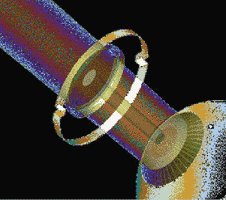 ---The Summit Apex
Plus/Infinity LS corrects hyperopia with or without astigmatism. It
uses “mask in rail” or Emphasis Disc technology with a beam diameter
up to 9.5 mm.
---The Summit Apex
Plus/Infinity LS corrects hyperopia with or without astigmatism. It
uses “mask in rail” or Emphasis Disc technology with a beam diameter
up to 9.5 mm.
WAILEA, U.S.A. — Hyperopic laser in situ keratomileusis (LASIK) for patients with hyperopia up to +6 D of sphere and up to 3 D of cylinder indicates promising results out to 9 months when using the disc technology of the Summit (Waltham, U.S.A.) Apex Plus Excimer Laser Workstation. Combined data from two centers in a multicenter study show that stability is achieved in all eyes during the 3- to 6-month interval, as well as excellent postoperative uncorrected visual acuity (UCVA) and a low incidence of safety issues.
“I believe this is really exciting because astigmatic hyperopes treated with LASIK is the last group that hasn’t been approved yet by the U.S. Food and Drug Administration [FDA],” said Stephen F. Brint, MD, a refractive surgeon in private group practice in Metairie, U.S.A.
“I am very happy with the results,” Dr. Brint said. “I believe these are the best results that anyone has reported for hyperopia, with or without astigmatism, with any of the various lasers. These are better results than have been reported with either the flying spot laser or with the other broad-beam system [Visx, Santa Clara, U.S.A.].”
Disc technology
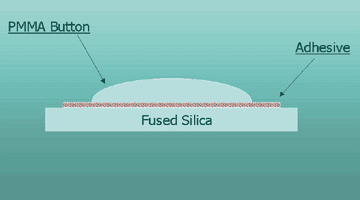 ---Hyperopic disk construction using the Summit Apex
Plus/Infinity LS.
---Hyperopic disk construction using the Summit Apex
Plus/Infinity LS.
Unlike the Visx excimer laser, which uses a scanning slit for hyperopic treatment, the Summit laser uses disc-in-the-rail technology. “This creates a 6.5-mm hyperopic or hyperopic astigmatic ablation that corrects either compound hyperopic astigmatism or mixed astigmatism,” Dr. Brint said.
The blend zone also extends out to 9.5 mm. “The Summit laser workstation appears to create the largest effective optical zone with the smoothest ablation pattern,” he said. However, “there is actually very little energy out at 9.5 mm, so if a few pulses do get peripheral to the stromal bed or are starting to touch the hinge, I don’t think it really affects anything significantly because there is minimal energy out at that level.”
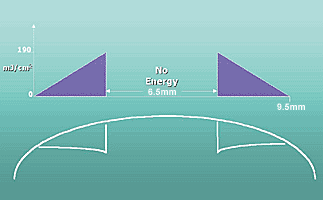 ---Axicon Energy
Profile using the Summit Apex Plus/Infinity LS.
---Axicon Energy
Profile using the Summit Apex Plus/Infinity LS.
The Summit-sponsored multicenter study included 600 eyes of 317 patients. Hyperopia ranged from 1 D to 6 D, with astigmatism of up to 3 D. Combined data from Dr. Brint and Daniel S. Durrie, MD, of Kansas City, U.S.A., were presented here at the Hawaii 2000 meeting, sponsored by Ocular Surgery News and the New England Eye Center. The two surgeons entered 135 eyes into the study, with 96 eyes at 3 months, 59 at 6 months and 25 eyes out to 9 months. “We started out with about +2.5 D manifest refraction spherical equivalent,” Dr. Brint said. “The 3-month data, the 6-month data and the 9-month data all show stability. Intended stability was within ±0.5 D for 80% of eyes at 9 months.” Furthermore, 90% of eyes at 3 and 6 months and 100% at 9 months achieved within ±1 D. “I’m very happy with the stability from 3 months to 9 months,” Dr. Brint said. “The predictability lasts with time.”
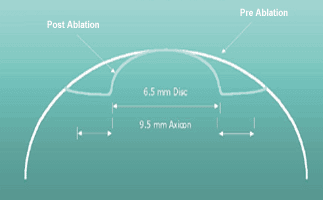 ---Disk and Axicon hyperopic correctionwith the
Summit Apex Plus/Infinity LS.
---Disk and Axicon hyperopic correctionwith the
Summit Apex Plus/Infinity LS.
More significant, however, are the visual acuity results. At 6 months, “about 20% of patients were 20/16 or better uncorrected, about 55% were 20/20 or better, and a little over 70% were 20/25 or better,” Dr. Brint said. “Remember, these results were achieved strictly with the P disc, which is the disc that corrects both hyperopia and astigmatism.”
Loss of BCVA
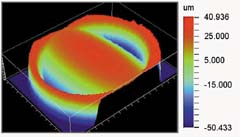 ---Summit P5045 disc for compound hyperopic
astigmatism. +5 D sphere -4.5 D cylinder.
---Summit P5045 disc for compound hyperopic
astigmatism. +5 D sphere -4.5 D cylinder.
Regarding safety issues, 4.7% of patients in the multicenter study lost more than two lines of best corrected visual acuity (BCVA). “But in those eyes that lost greater than two lines, 4% of the 4.7% still had a BCVA of 20/20 or better,” Dr. Brint said. “So we’re only talking about going from 20/10 to 20/20 as opposed to going from 20/20 to 20/30.” In their centers, Drs. Brint and Durrie recorded no other adverse events.
At the meeting, it was mentioned that hyperopic laser studies from both Visx and Summit indicate that flat stability and no regression is possible long term.
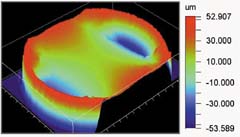 ---Summit P4060 disc for mixed hyperopic
astigmatism. +4 D sphere -6 D cylinder.
---Summit P4060 disc for mixed hyperopic
astigmatism. +4 D sphere -6 D cylinder.
“I feel that we’re starting to get a better handle on our nomograms and a better handle on our flap management. These changes obviously followed some of the original hyperopia works,” Dr. Brint said. “I believe inherently hyperopic LASIK is going to be more stable than the other hyperopic modalities that are currently being investigated right now. At some of the international meetings, we’ve heard results comparing all the various hyperopic modalities. It seems as though hyperopic LASIK, by far, is the most stable.” In any event, “we’re extremely pleased with our results and looking forward to FDA approval in the near future for this final addition to the armamentarium,” he said.
For Your Information:
- Stephen F. Brint, MD, can be reached at Brint Vision Correction Center, 3901 Veterans Blvd., Metairie, LA 70002 U.S.A.; +(1) 504-888-2020; fax: +(1) 504-888-2929; e-mail: brintmd@aol.com. Dr. Brint has no direct financial interest in any product mentioned in the article. Dr. Brint is a paid consultant for Summit Technology.
- Summit Technology Inc. can be reached at 21 Hickory Drive, Waltham, MA 02154 U.S.A.; +(1) 781-890-1234; fax: +(1) 781-890-0313.
- Visx Inc. can be reached at 3400 Central Expressway, Santa Clara, CA 95051-0703 U.S.A.; +(1) 408-773-7158; fax: +(1) 408-730-1399.
